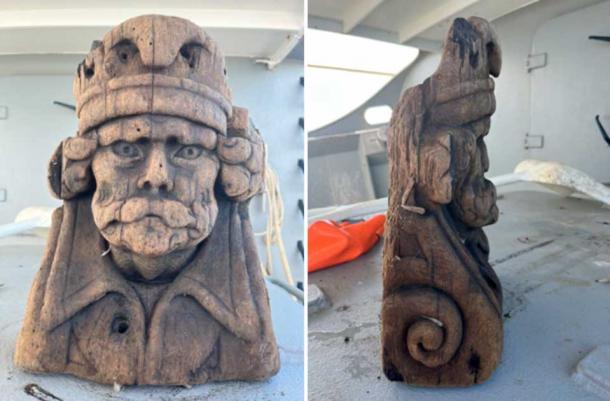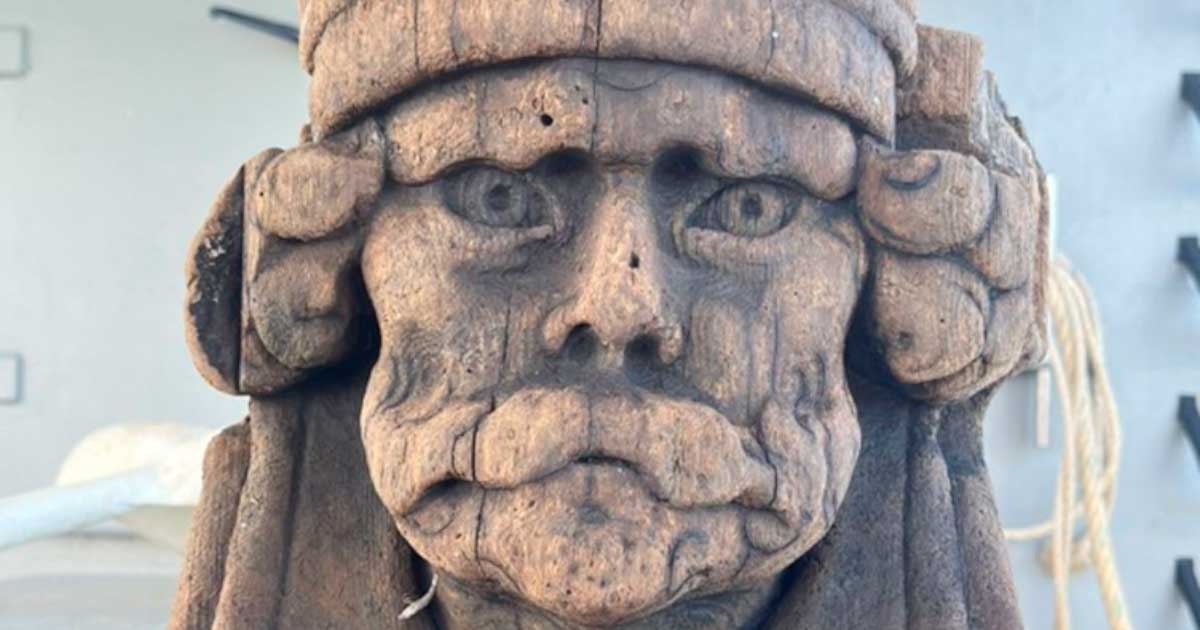400-year-old Ship Figurehead from 80 Years War Caught By Dutch Shrimpers!
An exceptionally well-preserved ship figurehead, in the form of a wooden statue, was “caught” by a shrimp boat crew off the coast of Texel Island in the Dutch Wadden Islands. This super-rare ship figurehead example was in mint condition, and adorned with a special headdress, called a Phrygian cap, which was a strong reference to emancipation from slavery, and thus liberty and independence.
Seemingly submerged since the 17th century, it is thought that the ship figurehead came from a warship that sank during the Dutch Eighty Years’ War with the Spanish from 1566/8-1648 AD. The find was excitedly shared by a crew member on Twitter, in which he also asked for more information about its origins and history.
The Discovery of the Rare ‘Perfect’ Ship Figurehead
The crew of shrimp boat Wieringer 22 found the exceptional ship figurehead in their fishing nets, off the coast of the Dutch Wadden Islands (or Frisian Islands). Made of solid oak, the statue’s powerful head and face was luckily buried so deep into the sea floor that it completely escaped deterioration or shipworm degradation.
The find has been named by the crew members as “Barry.” It has been termed a “very special discovery” by Michiel Bartels, a municipal archaeologist from the region, who dated the statue to the Eighty Years War.
- Did the Conquest of the New World Save the Spanish Empire?
- Battles on Ice Skates in the 1500s: The Dutch Against The Spanish!
The sea floor sediment acted as a near-perfect preservation capsule for the ship figurehead, preventing marine organisms from feeding on the wood, and general long-submersion waterlog damage. On the advice of marine archaeologists, the head was placed by the crew in an eel tub filled with seawater, preventing the wood from drying out and deteriorating, reported Danish daily Leeuwarder Courant.

Front and side view of the well-preserved wooden ship figurehead, fished out of the sea by the shrimping crew off the coast of Texel Island in the Dutch Wadden Islands, on August 1st 2022. (Victor Ayal)
Barry, The Ship Figurehead, And His “Liberty Slave” Cap
Referring to the Phrygian cap that was so obvious on the head of the statue, Bartels added, “This hat symbolizes freedom and independence. The Phrygians were enslaved by the Romans. Slaves were shaved bald. When released from slavery, [Phrygians] wore a cap to hide their baldness and signify their freedom.”
In fact, European and colonial cultures used red Phrygian caps to symbolize liberty for centuries. During the French and American revolutions, they would become symbols of allegiance to the cause, and several peoples in Eastern Europe, Anatolia, and the Balkans adopted the symbol of the Phrygians.
The original cap of liberty was adopted by the emancipated slaves of Rome and referred to as the “pileus,” attributed to Libertas, the Roman goddess of liberty. The oldest depiction of this cap has been founded at Persepolis in Iran, the ceremonial capital of the Achaemenid Empire (550–330 BC), when freed Persians, Medes, and Scythians all adopted the freedom cap.
- The Spanish Inquisition: The Truth behind the Dark Legend (Part I)
- The Kingdom of Hayti and the Slave that Pronounced Himself King
All The Religious Reasons For the Eighty Years War
The Dutch Eighty Years War was an armed conflict that started in Habsburg, Netherlands in the 1560s between groups of rebels and the Spanish government that ruled Holland then. They clashed over the Reformation, taxation, and the extreme inequalities in society that caused increasing tensions between the rich and the poor.
The Spanish were dominant in the distant northern Netherlands through royal marriages, political arrangements, and compliant Dutch attitudes. It was a socio-cultural conquering of the Netherlands that required no invasions.
The Netherlands was ruled by the Spanish Catholic King Philip II who was the son of Charles V, the Holy Roman Emperor (reigned 1519-1556). King Philip II continued and broadened his father's anti-Protestant policies. Charles V was behind the introduction of the Inquisition to the Netherlands and this led to protests among the Dutch.
In the end, it was King Philip II’s decision to counter the Reformation protests by having all his subjects swear allegiance to the Catholic Church that led to war on land and on the seas between the two sides.
The Eighty Years War led to Dutch independence in 1581 and the formation of the Dutch Republic.
Top image: The rare and exceptionally preserved Dutch wooden ship figurehead found off the island of Texel in the Wadden Islands in early August 2022. Source: Victor Ayal
By Sahir Pandey
References
Altuntas, L. 2022. Dutch Shrimp Fishermen caught a centuries-old carved wooden statue off the coast of Texel. Available at: https://arkeonews.net/dutch-shrimp-fishermen-caught-a-centuries-old-carved-wooden-statue-off-the-coast-of-texel/.
Lalor, A. 2022. What was the Eighty Years’ War? The Dutch War of Independence explained. Available at: https://dutchreview.com/culture/history/what-was-the-eighty-years-war-the-dutch-war-of-independence-explained/.
Veltman, L. 2022. Garnalenvissers melden bijzondere vangst op de Waddenzee. Maar wat is het? Available at: https://lc.nl/friesland/Garnalenvissers-melden-bijzondere-vangst-op-de-Waddenzee.-Maar-wat-is-het-27848018.html.



















